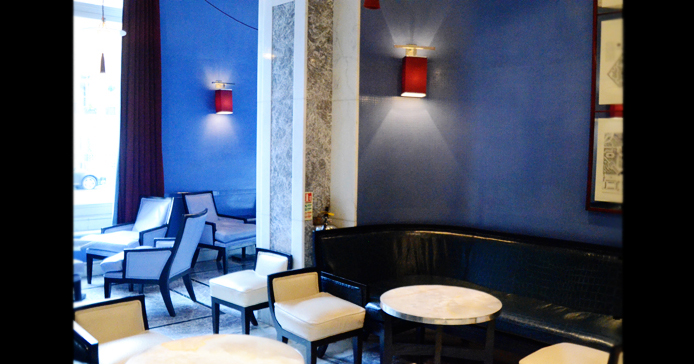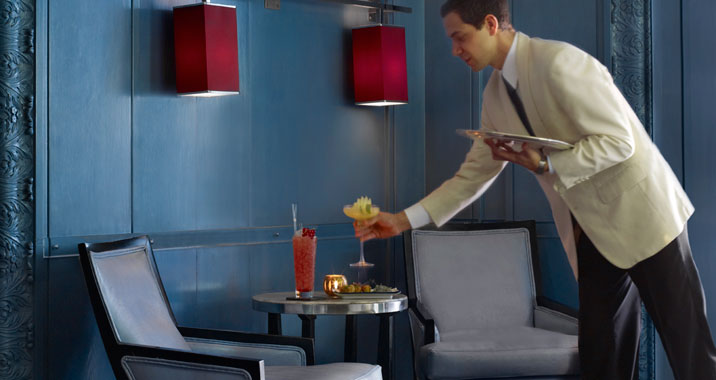“The Blue Bar, an exceedingly popular haunt of the rich, famous and downright stylish ever since it opened at the Berkeley Hotel in 1999, is such a beautifully serene and luxurious space that at first it is hard to comprehend just how daring it is.”
Dublin-born designer David Coolins rarely puts a foot wrong, despite his willingness to go out on a limb and stir up a little controversy. The Blue Bar, an exceedingly popular haunt of the rich, famous and downright stylish ever since it opened at the Berkeley Hotel in 1999, is such a beautifully serene and luxurious space that at first it is hard to comprehend just how daring it is. It said that Madonna has had the design replicated in her own home, while fashion designer John Galliano calls it his “favourite home from home”. That may be a bit of a stretch for those of us who don’t have achingly cool drawing rooms in our own abodes, but at least we can all share the benefit of relaxing with a cocktail or slowly perusing the list of 50 whiskies in this intimate, unhurried space.
A beguiling mix of the contemporary and the traditional informs the whole design and has made the bar a perfect place for the reawakening of cocktail culture. The customers are stylish and adventurous, choosing from an excellent cocktail list that includes both classics and new departures. The bar menu features, modern twists and tapas, such as queen scallops with wasabi and lime vinaigrette which, like the bar itself, are small and perfectly formed. The bar has also positioned itself for the re-emergence of cigar culture, which has risen in popularity alongside the clamorous demands for total smoking bans. The Blue Bar has a “Grape and Smoke” menu which matches particular wines with cigars – a contemporary twist on a traditional English sensibility that is typical of the Blue Bar. However, the cigar-puffing customers are more likely to be young women in Manolo Blahniks than old gents in smoking jackets.
The Blue Bar’s name may give the game away but the décor is still a surprise. It is a monochrome delight, where the emphasis on a single colour has been restrained from becoming visually overbearing by dexterous subtlety. The blue walls verge on typical Wedgwood, but have been given a gentle warmth by brushing red powder into the delicately cracked paint. Comparison to Wedgood could continue, but whereas the china often features white swags, the intricate carvings on the Blue Bar’s walls are the same colour as the background. David Collins has called the colour Lutyens Blue. Its name highlights the designer’s strength of character. The wood paneling and carvings, designed by Sir Edwin Lutyens (1869 – 1944), survive from original Berkeley before the hotel relocated to its current, purpose-built home in 1972. In the new hotel building, designed by Martin O’Rourke, they were placed in a sitting room which became known as the Lutyens room. In turning the room into the Blue Bar, Collins took the hotel’s main historical feature and covered it with blue paint. Some followers of Lutyens, a prestigious architect wose work includes Drogo Castle, the Viceroy’s house in New Delhi and the Cenotaph, think of Collins decision to paint the intricate carvings as sacrilege. For others, Collins has brought the carvings alive again, giving both the room – and the reputation of the Berkeley – a contemporary zing.
Far from being deliberately outrageous, Collins has tipped his hat with respect to Lutyens throughout the design. The cardinal’s hat light in the center of the ceiling’s white, decorated recess is based on one Lutyens own designs, while the black, crocodile leather flooring and black chair frames allude to the architect’s repeated use of the colour. The bar’s drawing-room design also refers to Lutyen’s reputation as one of the foremost designers of English country houses. The counter is often the focus of bar design, but here it is placed at the end of the room and blends into the overall scheme, aided by the lightness of the onyx counter-top and setting of the bottle displays into two bookshelf-like recesses. It isn’t allowed to dominate the room, encouraging the guests to think of the bar as a private sitting room. If you are looking for some very nice furniture for bars and restaurants you should have a look Atlantic shopping, they have lot of products that will fit in bars like Blue Bar
As well as drawing on faux-Renaissence influences, the Blue Baris also inspired by Art Deco, the design style which will always be associated with the golden age of the cocktail. The blue-leathee, sloping-black chairs, and large Modern rug add an air of comfort, glamour and worldly sophistication that make it hard to move on to another bar. The secret to the Blue Bar’s success is that although it is a calm, unpretentious oasis where everyone from celebrities to local fashionistas to the hotel guests are treated as equal. The witty design ensures its continued popularity because its blend of history, tradition, contemporariness and risk allows to be unique and timeless, with no hint of wannabe desperation.




